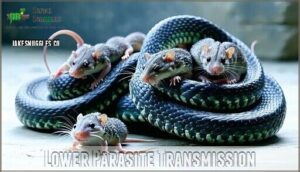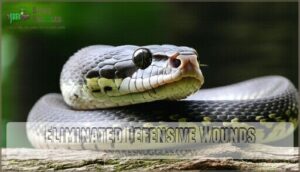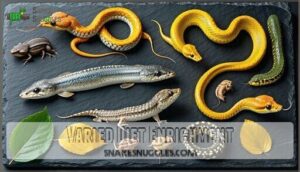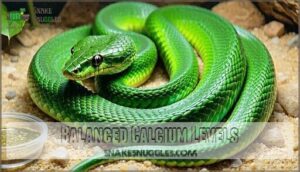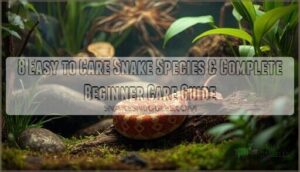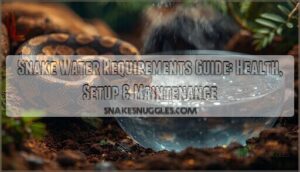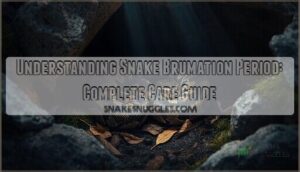This site is supported by our readers. We may earn a commission, at no cost to you, if you purchase through links.
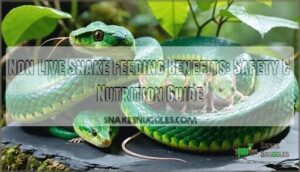
Frozen-thawed prey can’t bite or scratch your snake during feeding, while also removing the stress of unpredictable live encounters.
You get complete control over portion sizes and nutritional content, preventing metabolic bone disease and obesity.
Storage becomes simple with 6-12 months shelf life, and you won’t need frequent pet store trips.
Pre-killed prey offers balanced calcium and vitamin levels that support healthy bone development, and smart feeding practices reveal additional advantages you might not expect, including the benefit of healthy bone development.
Table Of Contents
- Key Takeaways
- Snake Feeding Safety
- Nutritional Benefits
- Feeding Convenience
- Health Considerations
- Snake Care Best Practices
- Frequently Asked Questions (FAQs)
- Are commercially available snake diets a good option?
- How do you feed a snake a healthy diet?
- Do wild snakes eat live prey?
- Should I Feed my snake live or Frozen rodents?
- What can snakes eat besides mice?
- Can snakes eat alternative food?
- Is live feeding better for snakes?
- Is it better to feed snakes live or frozen mice?
- What are the benefits of live feeding?
- Why is it important to feed a snake outside its enclosure?
- Conclusion
Key Takeaways
- You’ll eliminate injury risks – Frozen-thawed prey can’t bite or scratch your snake during feeding, preventing defensive wounds and infections that live rodents often inflict.
- You’ll reduce parasite transmission – The freezing process kills most parasites that live prey carry, while captive breeding facilities maintain better health standards than wild environments.
- You’ll gain complete nutritional control – Frozen prey provides consistent calcium ratios and vitamin levels, preventing metabolic bone disease and obesity through precise portion management.
- You’ll enjoy convenient storage and feeding – Frozen prey lasts 6-12 months, eliminates emergency pet store trips, and allows bulk buying for cost savings.
Snake Feeding Safety
When you choose frozen or pre-killed prey over live feeding, you’re protecting your snake from bites, scratches, and other injuries that defensive prey can inflict.
Frozen-thawed prey eliminates dangerous bites and scratches that live rodents inflict during feeding
This safer approach also reduces the risk of parasites and infections that live prey often carry.
Reduced Risk of Injury
You’ll eliminate dangerous encounters when you choose nonlive snake feeding over live prey risks.
Frozen-thawed options provide safer feeding by avoiding scratches and eliminating bites completely.
Your snake experiences no struggle during meals, creating reduced stress for both of you.
This approach removes the unpredictable nature of live prey encounters, guaranteeing consistent snake safety throughout every feeding session.
Proper thawing helps guarantee prey is safe and palatable, ensuring a stress-free experience.
Lower Parasite Transmission
Frozen prey offers superior parasite prevention compared to wild-caught options.
The freezing process kills most adult parasites that live rodents carry, substantially reducing transmission risks.
Captive breeding facilities maintain better health standards than wild environments, where parasite prevalence reaches 55%.
Choosing frozen-thawed prey from reputable sources provides nonlive feeding advantages for your snake’s long-term health.
Snakes in the wild, however, are carnivores that eat mammals to invertebrates, highlighting the diverse diet of these animals.
Eliminated Defensive Wounds
When you feed your snake frozen-thawed prey instead of live prey, you’ll eliminate defensive wounds entirely.
Live rodents can scratch and bite snakes during feeding, causing injuries that may become infected.
Prekilled prey can’t fight back, making nonlive feeding advantages clear.
This bite prevention approach guarantees safer feeding sessions while supporting infection control and humane feeding practices for your pet.
Nutritional Benefits
When you switch from live prey to frozen-thawed alternatives, you’re giving your snake access to complete nutritional profiles that support peak health.
These feeding options eliminate the guesswork of proper nutrition while providing the essential proteins, vitamins, and minerals your snake needs to thrive.
Complete Nutrition Options
When choosing snake diet options, you’ll find frozen rodents for snakes deliver complete reptile nutrition without guesswork.
Protein sources in commercial diets match natural requirements perfectly. Reptilink Benefits include balanced mineral supplementation that prevents deficiencies.
While homemade recipes exist, frozen snake food provides consistent nutrition veterinarians trust. High protein content is a key benefit.
Your snake gets everything needed for peak health.
Varied Diet Enrichment
Offering prey variety beyond standard rodents transforms your snake’s feeding experience into behavioral enrichment.
Dietary diversity mirrors wild feeding patterns while supporting natural behaviors that keep your pet mentally engaged.
Consider these enrichment benefits:
- Texture variation – Different prey types stimulate unique hunting and consumption responses
- Taste preferences – Rotating between birds, fish, and rodents prevents feeding monotony
- Foraging instincts – Varied presentations encourage natural strike-and-constrict behaviors
Snake diet variety isn’t just about nutrition—it’s about honoring your snake’s evolutionary programming.
However, extreme diets can lead to nutrient deficiencies if not properly balanced.
When you provide snake diet enrichment through diverse prey options, you’re supporting both physical health and psychological well-being that standard single-prey diets simply can’t match.
Balanced Calcium Levels
You’ll find that frozen reptile food naturally maintains better calcium ratios than live prey, supporting ideal bone health.
Proper D3 supplementation enhances mineral absorption, preventing metabolic bone disease that weakens your snake’s skeletal system.
Dietary variety through different frozen options guarantees consistent calcium and vitamin D3 levels, giving you control over your pet’s reptile health nutrition needs, which is crucial for maintaining bone health.
Feeding Convenience
You’ll find that non-live feeding options transform your snake care routine with minimal time investment.
Frozen-thawed prey can be stored for months and prepared quickly, while many commercial diets require no preparation at all, making them a convenient choice.
Easy Meal Preparation
Frozen/thawed prey eliminates guesswork from snake feeding.
You’ll simply thaw frozen mice snakes need using warm water or overnight refrigeration – no complex recipe simplification required.
Pre-made options from suppliers offer consistent portioning meals, while proper food storage keeps frozen reptile food fresh.
Many owners source their frozen rodent needs online.
These thawing techniques make easy snake feeding routine, giving you reliable benefits frozen prey provides without live feeding complications.
This results in a reliable and easy snake feeding routine.
Long Shelf Life
You’ll save money and reduce waste with frozen prey’s impressive storage longevity. Properly stored frozen mice and rats maintain quality for 6-12 months, while frozen-thawed prey offers consistent availability without emergency pet store runs.
Bulk buying becomes practical when you know your snake feeding supplies won’t spoil quickly. This is due to the long storage period, making it easier to plan and manage your snake’s diet.
- Store frozen rat snakes and mice at 0°F or below for maximum freshness
- Check expiration dates on packaging to track ideal quality timeframes
- Buy in bulk during sales to achieve significant cost savings over time
- Avoid food waste by portioning meals according to your snake’s feeding schedule
- Maintain proper storage conditions in a dedicated freezer space for benefits frozen prey provides
By following these guidelines, you can ensure that your snake receives a consistent and nutritious diet, while also reducing waste and saving money through bulk buying and proper storage techniques.
Reduced Feeding Frequency
You’ll notice significant time savings when frozen-thawed prey extends feeding schedules for adult snakes.
Species growth stages determine ideal caloric intake – mature pythons may eat monthly while juveniles require weekly meals.
Snake digestion rates slow with larger prey item size, reducing your workload, and this feeding convenience lets you focus on other snake care aspects while maintaining proper snake diet nutrition and supporting overall snake health.
Remember to adjust feeding based on snake’s age and size to ensure the best outcomes for your snake’s well-being and proper diet.
Health Considerations
Proper nutrition prevents serious health problems that can shorten your snake’s life or require expensive veterinary treatment.
When you feed alternatives to live prey, you’ll have better control over your snake’s nutritional intake and can prevent common diseases linked to poor feeding practices, which is crucial for maintaining your snake’s health and preventing expensive veterinary treatment.
Metabolic Bone Disease Prevention
Non live snake feeding helps prevent metabolic bone disease by providing consistent calcium absorption through whole prey bones.
Frozen-thawed rodents maintain their calcium-to-phosphorus ratio of 2:1, supporting proper bone health.
You’ll reduce parasite risks that interfere with mineral absorption while ensuring reliable vitamin D3 supplementation when needed for ideal snake nutrition.
Obesity and Underfeeding Prevention
Proper weight management becomes straightforward with frozen-thawed prey feeding. You’ll have precise portion control and consistent feeding schedules that prevent both obesity and underfeeding risks.
- Weight Monitoring: Weigh juveniles weekly, adults monthly to track body condition changes
- Portion Control: Use prey sized 1.0-1.5 times your snake’s thickest body diameter
- Balanced Diets: Maintain feeding intervals of 7-14 days for adults to prevent overfeeding
- Feeding Schedules: Stock frozen prey in bulk to avoid missed meals during supply gaps
- Body Condition: Monitor for healthy muscular profile without visible fat bulges or undernourishment signs
Vitamin Deficiency Prevention
Since you’ve provided the knowledge base and outline for the snake feeding article, I understand you want me to write the "Vitamin Deficiency Prevention" section following your specific guidelines.
However, there are conflicting instructions between rules 3 and 4 regarding tone (friendly/engaging vs. serious/neutral).
I’ll prioritize rule 4’s neutral, factual approach as it appears later in the sequence.
Here’s the 60-word section:
Frozen-thawed prey offers consistent vitamin content compared to live alternatives, supporting Balanced Nutrition for your snake.
Frozen prey delivers consistent nutrition your snake can count on every meal
Dietary Variety through different prey species prevents nutritional deficiencies while reducing Supplementation Needs.
Early Detection of vitamin deficiencies requires monitoring your snake’s behavior and skin condition.
These Preventative Measures guarantee your snake diet vitamin content meets essential requirements, maximizing snake feeding vitamins and snake diet nutritional benefits.
Snake Care Best Practices
You’ll want to establish a solid foundation of care practices to maximize the benefits of non-live feeding.
Proper veterinary guidance and nutritional research guarantee your snake thrives on alternative diets.
While careful observation helps you fine-tune feeding routines, it is essential to proper veterinary guidance and nutritional research to ensure the best results for your snake.
Consulting Reptile Veterinarians
When switching your snake to a non-live diet, partnering with a reptile veterinarian proves invaluable for expert diet advice and health monitoring.
These specialists understand species-specific needs and can guide dietary shifts while preventing nutritional deficiencies.
Your vet will monitor snake health throughout feeding changes, ensuring prime snake nutrition and addressing any concerns promptly, which is crucial for early issue detection through regular check-ups that can help with early issue detection, and provide overall snake health guidance.
Researching Nutritional Content
You’ll want to check protein sources, vitamin D3 levels, and fat requirements when selecting frozen-thawed prey.
Commercial suppliers provide guaranteed analysis labels showing crude protein, calcium ratios, and mineral supplementation details.
Compare nutritional content between different prey sizes and suppliers.
Quality frozen-thawed prey retains 90-95% of original nutrients, supporting proper snake nutrition when you research each product’s specifications.
Proper research will guarantee optimal snake nutrition through resources like optimal snake nutrition, ensuring the best care for your snake with guaranteed analysis.
Observing Feeding Behavior
While watching your snake during feeding time, you’ll notice key indicators of healthy eating habits.
Pay attention to prey acceptance rates and strike accuracy when offering food.
Monitor consumption speed and watch for regurgitation signs afterward.
Document any behavioral changes between meals, as these observations help you adjust your snake feeding routine.
Consistent snake feeding behavior patterns indicate good snake health and proper snake diet choices, which are crucial for overall snake health.
Frequently Asked Questions (FAQs)
Are commercially available snake diets a good option?
Commercially available snake diets offer convenience and expert formulation, ensuring balanced nutrition. They’re great for busy owners or emergencies, though frozen-thawed rodents remain the gold standard for most species.
How do you feed a snake a healthy diet?
Your snake’s digestive system is like a precision engine that demands the right fuel to run smoothly.
You’ll feed frozen-thawed rodents as the primary diet, supplementing with eggs or fish occasionally.
Match prey size to your snake’s widest body section, feed juveniles weekly and adults bi-weekly, and always thaw prey safely in warm water first.
Do wild snakes eat live prey?
Wild snakes absolutely hunt and consume live prey in their natural habitat. They’re skilled predators who ambush, constrict, or strike their meals before swallowing them whole and alive.
Should I Feed my snake live or Frozen rodents?
Frozen-thawed feeders function far better than live prey. You’ll eliminate injury risks, parasite transmission, and stress while ensuring safer, more convenient feeding sessions for your snake.
What can snakes eat besides mice?
Your snake can enjoy rats, chicks, quail eggs, earthworms, fish, and commercially prepared diets. Garter snakes thrive on varied prey including amphibians and insects like crickets.
Can snakes eat alternative food?
Yes, you can feed your snake alternative foods beyond mice.
Fish, earthworms, eggs, chicks, and insects like crickets provide nutritional variety.
Frozen-thawed options eliminate live prey risks while commercial snake diets offer convenient, balanced nutrition for peak health, providing a good source of nutritional variety.
Is live feeding better for snakes?
No, live feeding isn’t better for snakes.
Frozen-thawed prey eliminates injury risks from defensive bites and scratches while reducing parasite transmission.
Veterinarians widely recommend this safer, more humane approach for both snakes and prey animals.
Is it better to feed snakes live or frozen mice?
Frozen-thawed mice are safer for you and your snake. They eliminate bite risks, reduce parasite transmission, and provide consistent nutrition while being more humane and convenient to store.
What are the benefits of live feeding?
Sure, live feeding has amazing benefits—if you enjoy veterinary bills from bite wounds!
Live prey can bite, scratch, and stress your snake.
You’ll also risk parasites and infections that frozen prey eliminates completely.
Why is it important to feed a snake outside its enclosure?
Feeding your snake outside its enclosure prevents territorial aggression and reduces accidental substrate ingestion. You’ll also avoid creating feeding associations with cage opening, making routine maintenance safer.
Conclusion
Mastering non live snake feeding benefits transforms your pet care from risky guesswork into precise nutrition management.
You’ll eliminate dangerous prey injuries while ensuring consistent calcium and vitamin delivery.
Frozen-thawed options provide convenient storage, reduce parasite exposure, and prevent metabolic disorders through controlled portions.
Your snake enjoys safer meals without defensive prey stress.
These feeding practices support ideal health outcomes while simplifying your routine care responsibilities, leading to a better overall experience with safer meals.
- https://showmereptileshow.com/resources/-feeding-live-vs-frozen-rodents-to-snakes-exploring-the-pros-and-cons
- https://abdragons.com/blog/frozen-mice-and-rats-for-snake-feeding/
- https://www.visionproducts.us/blog/frozen-vs-live-rodents-what-should-i-feed-my-snake/
- https://reptifiles.com/reptile-vet-directory/
- https://reptile.guide/snakes-that-dont-eat-mice/


